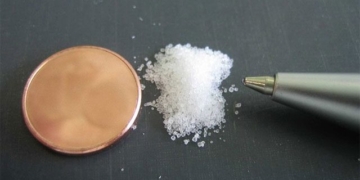Dengue fever (DF) can occur year-round and often experiences strong outbreaks, easily spreading into epidemics when humidity levels are high. According to the principles of Eastern medicine, the year of the Fire Dog (2006) is predicted to have higher than average rainfall and humidity, making the spread of DF more likely.
 |
Nodding Plant (Photo: TTO) |
The disease is named DF due to its two main symptoms: fever and hemorrhage. DF is caused by the Dengue virus and spreads rapidly, easily leading to outbreaks through its vector, the Aedes aegypti mosquito (known for its white-striped abdomen, legs, and wings).
The Aedes mosquito bites and draws blood from infected individuals, then transmits the virus to healthy people, creating a chain reaction of transmission (domino effect). Once an Aedes mosquito is infected with the Dengue virus, it carries the virus throughout its life cycle, allowing it to infect many individuals.
Anyone can contract DF, but children under 15 years old are the most susceptible. DF typically begins with three characteristic signs: sudden onset of fever, high fever, and continuous fever. During rainy and humid days, if a child who is normally eating and playing suddenly develops a high fever of 39-40oC, persisting day and night, along with symptoms such as fatigue, headache, abdominal pain, bloating, nausea, or vomiting, it is important to suspect DF.
DF is often classified into four levels, depending on the severity of clinical symptoms. Patients experience sudden, continuous, and prolonged high fever. Without timely treatment, after two days and nights, the disease can progress to level 2: the onset of hemorrhagic symptoms. Common manifestations of hemorrhage on the skin include tiny red spots, appearing on the lower legs, arms, abdomen, thighs, and sides…
Mucosal hemorrhage can present as nosebleeds, bleeding gums, and sometimes conjunctival bleeding or hematuria… In severe cases, gastrointestinal bleeding may occur: vomiting blood, passing blood in stools…
By level 3 (usually from the fourth day), patients may begin to show signs of shock; circulatory failure, rapid pulse, low blood pressure, accompanied by symptoms of cold, clammy skin, restlessness, agitation, or lethargy. At level 4, the risk of death is very high: the patient experiences severe shock, weak pulse that is difficult to detect, undetectable blood pressure, and may subsequently die.
Shock – the warning signal
Shock is the most dangerous complication of DF. Shock syndrome includes three states of bodily decline: decreased consciousness, lowered temperature, and decreased blood pressure. Decreased consciousness means the patient is no longer alert and responsive, becoming lethargic or delirious. Decreased temperature indicates that body temperature is lower than normal, especially in the extremities. Decreased blood pressure refers to arterial blood pressure dropping below normal levels.
In cases where a blood pressure monitor is not available, one can preliminarily detect shock by checking the pulse at the patient’s wrist: if shock is present, the pulse will be very weak; if shock is severe, the pulse may be undetectable.
It is crucial to be particularly vigilant, as many patients may not exhibit hemorrhagic symptoms but can still go into shock – which is the most critical complication. Therefore, it is important to recognize the “prodromal” signs – warning symptoms that indicate whether shock may occur. The prodromal signs of shock include:
1. The child is alert but suddenly becomes lethargic or restless.
2. There are severe abdominal pains that were not previously present or were minimal.
3. Cold hands and feet.
4. Changes in skin color, transitioning from normal to bluish, with grayish lips.
5. Decreased urination or no urination at all, with intense thirst.
Herbal Treatment
During dengue outbreaks, the majority of patients (around 70%) are treated at home. In cases of newly developed illness, classified as levels 1 and 2, with no shock symptoms present, one can use readily available herbal remedies at home for treatment.
Acute Phase, High Fever
Practical experience in managing DF in recent years has shown that upon detecting a patient with DF, using the following basic herbal remedy often yields very good results:
– Basic Remedy: 30g of Nodding Plant, 30g of Gotu Kola (or Bacopa), and 20g of Plantago (leaves and flowers). Clean all ingredients, place in a pot, cover with water, and boil to extract the juice for drinking, or crush the ingredients, add boiling water, and strain to drink throughout the day.
Adjustments: To enhance the treatment’s effectiveness, adjustments can be made based on specific symptoms as follows:
– If the patient feels cold, does not sweat, has a runny nose, and experiences back and neck pain: Use 15-20g of Shiso leaves (leaves and stems) to extract the juice or brew it strong and drink it hot, or consume Shiso leaves with hot porridge to induce sweating. After the fever, continue with the basic remedy.
– If the patient is vomiting or has diarrhea: Add 15g of Pogostemon and 5g of fresh ginger to the basic remedy and brew to drink.
– If the patient is dry heaving, has severe headaches, and intense thirst: Add 20g of Chinese Yam roots or 20g of Pueraria tuber powder (or mix 10g of starch powder into the herbal decoction) and brew to drink.
– In cases of constipation: Add 20g of Purslane or 20g of Malabar Spinach.
– In cases of hemorrhage: Increase the amount of Nodding Plant to 40-50g; or add 20g of Bloodwort leaves or 20g of Biota leaves (blackened) to brew and drink.
Recovery Phase
After using the above basic remedy, if the fever has subsided and the hemorrhagic spots have gradually faded, but the body remains fatigued, has poor appetite, dizziness, blurred vision, muscle aches, poor sleep, and loose stools… depending on specific conditions, one can use one of the following herbal remedies or dishes to help the body recover quickly:
Remedy 1: 30g of American Ginseng, 20g of Rehmannia, 15g of Scrophularia, 12g of Honeysuckle, 20g of Codonopsis, and 30g of roasted black beans. Brew this mixture daily for 3-5 days.
Remedy 2: 30g of Rehmannia, 2-3 slices of fresh ginger, and 50-60g of rice. Brew the Rehmannia and ginger to extract the juice, discarding the residue, and cook with rice to make porridge, adding a little rock sugar for sweetness, divided into several meals throughout the day for 3-5 days.
Remedy 3: 1kg of goat bones, 50-60g of rice, 2 fresh onions, 3-5g of fresh ginger, and sufficient seasoning. Crush the goat bones, simmer to extract the broth, then add rice to cook into porridge, season, and divide into meals throughout the day for 3-5 days.
Dietary Considerations
DF often causes blood to thicken (hypercoagulation), making circulation difficult. This is the primary cause of shock complications. Therefore, it is essential to ensure plenty of fluid intake to prevent blood from thickening. Patients can drink boiled water, orange juice, lemon water, or oral rehydration solutions… However, they should drink slowly and in small amounts to avoid rapid intake, which may cause vomiting or bloating. During treatment, avoid spicy, hot, dry, and hard foods. It is advisable to consume cooling foods such as starch powder, black beans, green beans, bean sprouts, fresh vegetables, and fruits…
Disease Prevention: In addition to exterminating mosquitoes, sleeping under a mosquito net to avoid bites, isolating infected individuals during outbreaks, one can continuously drink one of the following herbal teas for three days:
Remedy 1: 10g of Cassia seeds (roasted until black), steep for drinking instead of tea throughout the day.
Remedy 2: 10g of Sophora japonica flowers (roasted golden, crushed), steep for drinking instead of tea throughout the day.


















































